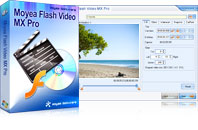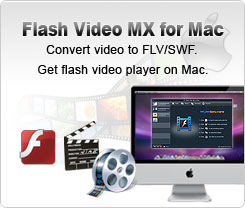Flash Video MX Pro
Moyea Flash Video MX Pro, with the main function of video to Flash, SWF conversion, supports H.264, Flash 8 alpha video, F4V video encoding, CuePoint and basic video editing! It provides also vivid video effects, a preloader, and a Flash Player,etcWhen you are surfing on the Internet, you would feel the pulse to publish some video clips, such as you DV video, on the web from time to time. The how to? With Flash video authoring tool, creating such a web compatible video and publish it is as easy as logging onto a website
.
The traditional way to publish a video clip on the web is to prepare the video a number of times to please a wide range of audience, and then try to explain to them how to play back the video online. Some people like Real Player, some Windows Media, or QuickTime, etc, all of which do not have 100% market coverage. When you choose any one of the video format for your distribution, how can you make sure that your video can reach the largest audience for you cannot force the audience to use software they don’t like. This is where Flash comes into handy.
Flash Video MX is a fine Flash encoder as well as FLV encoder and lets you encode your video files into streaming SWF and FLV, which is smaller in size than the conventional video formats, has control bar, playback settings, and thus convenient for you to share with other people online. This guide is to give you the instructions on how to encode video to FLV from Flash video and SWF files using Moyea Flash Video MX.
Step 1, Import video file to the encoder
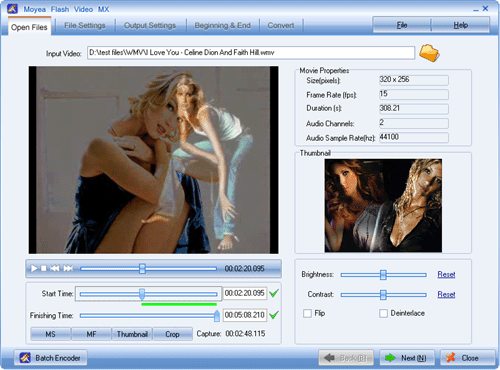
In the Open Files window, you can click on the browse icon to import the source video file into the program. Moyea Flash Video MX supports MPEG, MPG, WMV, ASF, AVI, MOV, MP4, RM, 3GP, etc.
Tips: In this step, you can: 1) access the basic information of the source video file, such as the frame size, frame rate, duration, channels, sample rate; 2) capture one frame of the video as the thumbnail for the generated FLV or SWF files; 3) deinterlace the video; 4) set the start time and the finishing time, etc.
Step 2, File Settings to adjust the video and audio settings
Click the Next button to go to the File Settings. This step is designed to set the setting parameters of the video and audio data: video codec, frame size, frame rate, bit rate, sample rate, channels, fade in, fade out, etc.
Bitrate is the number of bits used per unit of time to represent a continuous medium such as audio or video after data compression
Frame rate is the measurement of how quickly an imaging device produces unique consecutive images called frames. Frame rate is most often expressed in FPS (Frame per Second).
Tips: In this step, you may: 1) replace the original audio of your file with another to meet your requirement; 2) add video before the start time and after the end time.
Step 3, Output Settings to adjust the settings of the export files and the FLV player
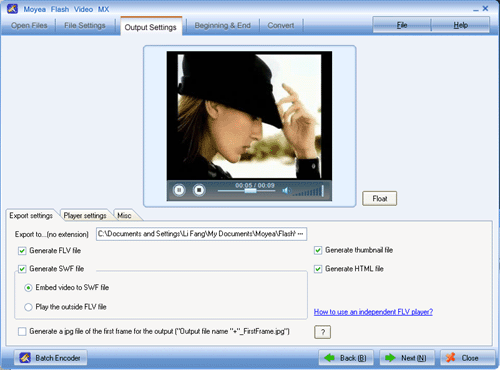
Click the Next button to go to the Output Settings.
Generate FLV file: Click this check box to generate FLV file with the settings you specified. If you uncheck this option, the option “Generate SWF file” is automatically checked.
Generate SWF file: There are two kinds of SWF files, one is the file embedded with video, and the other is FLV player to play the FLV file. When you check to generate the SWF file with embedded video, you can add video effect under the “Misc” tab. If you check to generate SWF as FLV player, video effect is disabled. When the option is unchecked, the option “Generate HTML file” will be grayed out and the option “Generate FLV file” will be automatically checked.
Player settings: Click this tab and you will be able to choose different control bars for the Generated FLV Player: the control bar, hyperlink, cue point, load mode, etc.
Tips: To publish this FLV file along with an FLV player, you have to click the check box of Generate HTML file.
Step 4, Beginning & End
Click on the Next button to go to the Beginning & End step.
The Beginning & End step is to customize the movie beginning and movie end for the converted FLV and SWF files for better and personalized online distribution
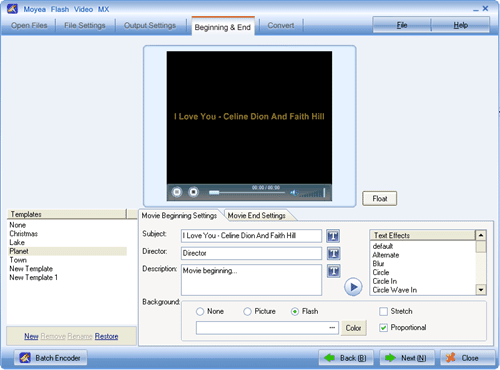 .
.
This step is most interesting. You can add movie beginning and movie end to the created FLV file or SWF file according to your liking, including the narration subject, director, description, background, text effects, stretch or proportional, etc.
Tips: For the movie beginning and end, the program has provided several templates for you to choose from.
Step 5, Convert and Publish
Click on the Next button and you will come to the Convert window. In this window, click Start button to activate the encoding process.
Tips: The basic information of the encoding will be displayed on the window interface: total length, current position, video bitrate, audio bitrate, elapsed time, left time.
Tips
- How to Play FLV with your browser
- FLV to AVI - Convert FLV to AVI video for BlackBerry
- Best way to convert M2TS to MKV without quality loss
- How to convert video to Flash (swf) and Flash video (flv)?
- Convert AVCHD to Samsung Galaxy S for playback with best M2TS/MTS Converter
- How to Play F4V and Convert F4V?
- Flash video encoder - Convert video to flash, get a FLV Player embedded HTML file
- FLV to Cell Phone: Convert FLV(Flash Video) video to Cell Phone with Moyea FLV Converter for Cell Phone
- FLV to DS : Convert FLV to DS with Moyea FLV to Video Converter
- MKV to MP4 - Convert MKV to MP4 for iPad with the best iPad format
 Promotion
Promotion




